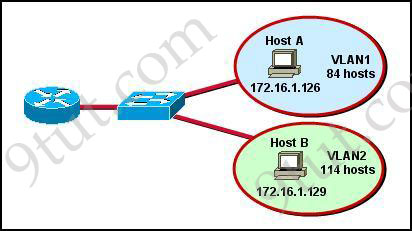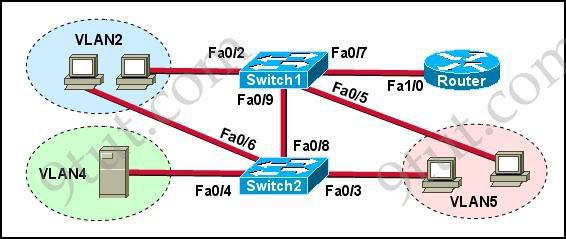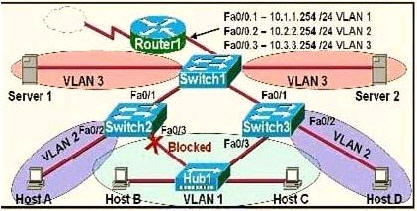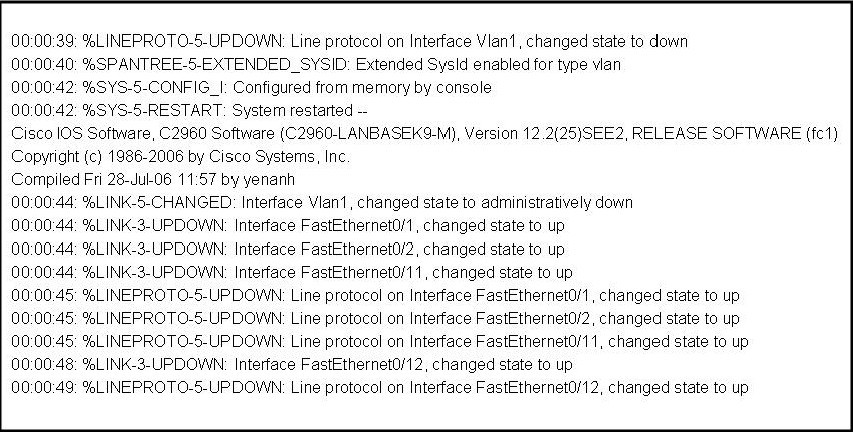CCNA – VLAN Questions 2
Here you will find answers to VLAN Questions – Part 2
Question 1
Which of the following are benefits of VLANs? (Choose three)
A. They increase the size of collision domains.
B. They allow logical grouping of users by function.
C. They can enhance network security.
D. They increase the size of broadcast domains while decreasing the number of collision domains.
E. They increase the number of broadcast domains while decreasing the size of the broadcast domains.
F. They simplify switch administration.
Answer: B C E
Explanation
When using VLAN the number and size of collision domains remain the same -> A is not correct.
VLANs allow to group users by function, not by location or geography -> B is correct.
VLANs help minimize the incorrect configuration of VLANs so it enhances the security of the network -> C is correct.
VLAN increases the size of broadcast domains but does not decrease the number of collision domains -> D is not correct.
VLANs increase the number of broadcast domains while decreasing the size of the broadcast domains which increase the utilization of the links. It is also a big advantage of VLAN -> E is correct.
VLANs are useful but they are more complex and need more administration -> F is not correct.
Question 2
Refer to the diagram. All hosts have connectivity with one another. Which statements describe the addressing scheme that is in use in the network? (Choose three)

A. The subnet mask in use is 255.255.255.192.
B. The subnet mask in use is 255.255.255.128.
C. The IP address 172.16.1.25 can be assigned to hosts in VLAN1
D. The IP address 172.16.1.205 can be assigned to hosts in VLAN1
E. The LAN interface of the router is configured with one IP address.
F. The LAN interface of the router is configured with multiple IP addresses.
Answer: B C F
Explantion
First we should notice that different VLANs must use different sub-networks. In this case Host A (172.16.1.126) and Host B (172.16.1.129) are in different VLANs and must use different sub-networks. But in this question, both answer A and B can separate VLAN 1 and VLAN 2 into different sub-networks . In particular, if the subnet mask is 255.255.255.192 we have
+ Sub-network 1: 172.16.1.0 -> 172.16.1.63
+ Sub-network 2: 172.16.1.64 -> 172.16.1.127 (assigned to VLAN 1)
+ Sub-network 3: 172.16.1.128 -> 172.16.1.192 (assigned to VLAN 2)
+ Sub-network 4: 172.16.1.192 -> 172.16.1.255
If the subnet mask is 255.255.255.128 we have 2 sub-networks:
+ Sub-network 1: 172.16.1.0 -> 172.16.1.127 (assigned to VLAN 1)
+ Sub-network 2: 172.16.1.128 -> 172.16.1.255 (assigned to VLAN 2)
But we should notice about the host part of each subnet mask. With 255.255.255.192 we have 2^6 – 2 = 62 hosts per subnet, which is smaller than the requirements of VLAN 1 (84 hosts) and VLAN 2 (114 hosts).
WIth 255.255.255.128 we have 2^7 – 2 = 126 hosts per subnet -> big enough for VLAN 1 & 2
-> B is correct.
The IP address 172.16.1.25, which is in the same sub-network with host A so it can be assigned to VLAN 1 -> C is correct.
To make different VLANs communicate with each other we can configure sub-interfaces (with a different IP address on each interface) on the LAN interface of the router -> F is correct.
Question 3
A network associate is trying to understand the operation of the FLD Corporation by studying the network in the exhibit. The associate knows that the server in VLAN 4 provides the necessary resources to support the user hosts in the other VLANs. The associate needs to determine which interfaces are access ports. Which interfaces are access ports? (Choose three)

A. Switch1 – Fa0/2
B. Switch1 – Fa0/9
C. Switch2 – Fa0/3
D. Switch2 – Fa0/4
E. Switch2 – Fa0/8
F. Router – Fa1/0
Answer: A C D
Explanation
Access ports are switch’s ports which are connected to hosts.
Question 4
What are three valid reasons to assign ports to VLANs on a switch? (Choose three)
A. to make VTP easier to implement
B. to isolate broadcast traffic
C. to increase the size of the collision domain
D. to allow more devices to connect to the network
E. to logically group hosts according to function
F. to increase network security
Answer: B E F
Question 5
Which statement is correct about the internetwork shown in the diagram?

A. Switch 2 is the root bridge.
B. Spanning Tree is not running.
C. Host D and Server 1 are in the same network.
D. No collisions can occur in traffic between Host B and Host C.
E. If Fa0/0 is down on Router1, Host A cannot access Server1.
F. If Fa0/1 is down on Switch3, Host C cannot access Server2.
Answer: E
Explanation
Switch 2 cannot be the root bridge because all ports of root bridges are designated ports. In the diagram switch 2 has one blocked port -> It is not the root bridge -> A is not correct.
Because Switch 2 has a blocked port so surely Spanning Tree Protocol is running -> B is not correct.
Host D belongs to VLAN 2 while Server 1 belongs to VLAN 3 so they are not in the same network -> C is not correct.
Host B & host C are connected through a hub so they are in the same collision domain and collision can occur -> D is not correct.
We need a router to allow different VLANs to communicate with each other. This router is called “router on a stick”. In this case it is Router1. The link between Router1 and Switch1 is configured as trunk link. If this link is down, different VLANs cannot communicate with each other -> E is correct.
If Fa0/1 is down on Switch3, Spanning Treel Protocol will “open” the blocked port on Switch 2 can Host C can access Server 2 through HostC -> Hub1 -> Switch2 -> Switch1 -> Router1-> Switch1 -> Server2 (notice that it must go through Router1 because they are in different VLANs). So F is not correct.
Question 6
Refer to the exhibit. Which of these statements correctly describes the state of the switch once the boot process has been completed?

A. As FastEthernet0/12 will be the last to come up, it will not be blocked by STP.
B. Remote access management of this switch will not be possible without configuration change.
C. More VLANs will need to be created for this switch.
D. The switch will need a different IOS code in order to support VLANs and STP.
Answer: B
Explanation
From the output we notice that the administrator has just shut down Interface Vlan1, which is the default VLAN so no one can access it remotely (like telnet) -> B is correct.
Answer A is not correct as STP calculation does not depend on which port comes up first or last. STP recalculates when there is a change in the network.
A normal switch can operate without VLAN -> C is not correct.
This IOS does support VLAN because it has VLAN 1 on it -> D is not correct.


